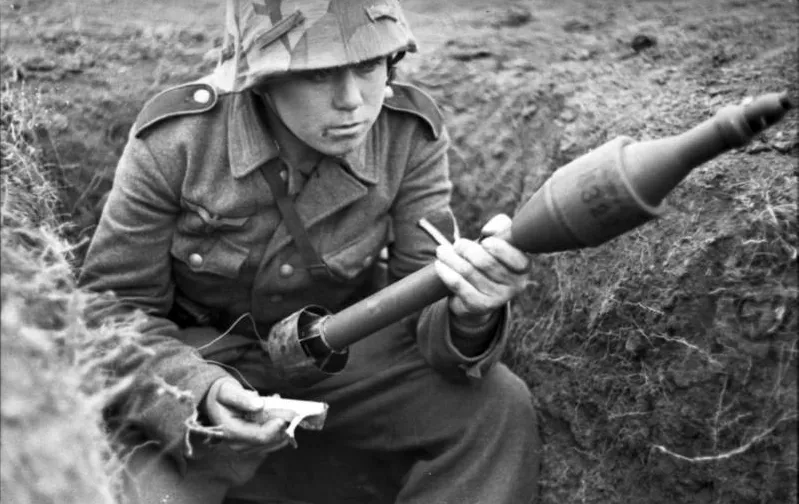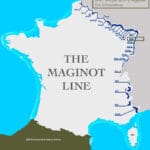Step into the world of the Panzerschreck, Germany’s fearsome anti-tank weapon of World War II. This monster-sized rocket launcher, nicknamed the “Tank Terror,” was a force to be reckoned with, shaping the destiny of Europe’s deadliest conflict. Its story is a captivating blend of history, engineering, and battlefield heroics. So, grab a drink and get ready for a mind-blowing adventure as we uncover the untold tales of the Panzerschreck’s reign.
Facts About Panzerschreck: The “Tank Terror” of WWII
Ever heard of the Panzerschreck? It’s not exactly a household name, but during World War II, this German anti-tank weapon sent chills down the spines of Allied tank crews. They called it the “Tank Terror,” and for good reason. But what’s really fascinating is that this fearsome weapon wasn’t entirely a German invention.
The Panzerschreck, which translates to “tank’s terror” or “tank’s fright,” actually started its life as the American M1 Bazooka. After capturing a few Bazookas, German engineers got to work, dissecting and analyzing them. Their goal? To make a good thing even better. And boy, did they succeed!
The result of their tinkering was a bigger, badder version of the Bazooka – the Panzerschreck. This beast of a weapon fired a rocket-propelled grenade that was significantly larger and more potent than its American counterpart. We’re talking about a weapon that could punch through the armor of Allied tanks like they were made of paper.
But the Panzerschreck’s versatility wasn’t limited to taking out tanks. One of the things that made it so effective was its ability to use different types of ammunition. Need to clear out an enemy infantry position? No problem, just load up a high-explosive round. Facing a heavily fortified bunker? Switch to an armor-piercing round and watch it crumble.
However, this weapon wasn’t without its drawbacks. Imagine firing this thing – pretty awesome, right? Well, there was a downside – a huge cloud of smoke and dust would erupt from the back of the weapon upon firing, basically creating a giant “Here I am!” signal for enemy troops. This back-blast was so intense it could injure anyone standing nearby, so the soldier firing it had to wear a protective mask and suit.
Despite these challenges, the Panzerschreck earned a fearsome reputation on the battlefields of World War II. The mere sight of this weapon was enough to strike fear into the hearts of Allied tankers, forcing them to be more cautious and always on the lookout for its distinctive shape.
The Panzerschreck stands as a testament to the ingenuity and ruthlessness of wartime engineering – a weapon that combined American inspiration with German innovation to create a truly formidable force on the battlefield.
Key Points about the Panzerschreck:
- Initially based on the American M1 Bazooka.
- Larger and more powerful than the Bazooka, with a wider grenade that could penetrate Allied tank armor.
- Versatile, with different ammunition types available for infantry and bunker warfare.
- Notable drawback: significant back-blast upon firing, requiring protective gear for the soldier.
- Earned a fearsome reputation on battlefields, striking fear into Allied tankers.
What are some interesting facts about the Panzerschreck?
The Panzerschreck was a unique weapon with a fascinating history. Here are some intriguing aspects of this German “Tank Terror”:
- Origins in Necessity: Developed in response to the increasing threat posed by Allied tanks, particularly the Soviet T-34, the Panzerschreck emerged from Germany’s need for a powerful, portable anti-tank weapon.
- Inspiration from the Enemy: The Panzerschreck’s design was heavily influenced by captured examples of the American Bazooka. However, German engineers significantly enhanced its capabilities, surpassing the original in both power and range.
- More Than a One-Trick Pony: While primarily designed for anti-tank warfare, the Panzerschreck’s versatility extended beyond engaging armored vehicles. Its ability to fire a variety of rounds made it suitable for tackling infantry, fortifications, and even, in some cases, low-flying aircraft.
- A Two-Man Operation: Though often depicted as a one-man weapon, the Panzerschreck was optimally operated by a two-man team. This allowed for quicker reloading and more effective target engagement, with one soldier aiming and firing while the other loaded the rockets.
- A Catalyst for Innovation: The Panzerschreck’s emergence sparked a mini-arms race, driving the development of increasingly powerful and sophisticated anti-tank weapons by both the Axis and Allied forces.
How Powerful Was the Panzerschreck?
The Panzerschreck was a game-changer on the battlefields of World War II, effectively leveling the playing field between infantry and tanks. Its power lay in its ability to deliver a devastating blow to even heavily armored targets.
- Armor-Piercing Prowess: The Panzerschreck fired an 88mm rocket-propelled grenade specifically designed to penetrate tank armor. This HEAT (High-Explosive Anti-Tank) round was capable of punching through over 200mm of steel plate, making it a formidable threat to even the most heavily protected Allied tanks.
- Respectful Range: While not as long-ranged as some artillery pieces, the Panzerschreck boasted an effective range of around 150 meters, allowing soldiers to engage enemy tanks from a relatively safe distance.
- Psychological Warfare: The Panzerschreck’s intimidating size and the distinctive roar of its rocket had a significant psychological impact on Allied tankers. The mere presence of Panzerschreck teams on the battlefield could force tankers to hesitate, disrupting their advances and giving German troops a tactical advantage.
It’s important to note that the exact number of tanks destroyed by the Panzerschreck is difficult to determine definitively. Battlefield records were not always accurate or complete. However, its impact on the course of the war is undeniable. The Panzerschreck shifted the balance of power, giving infantry a fighting chance against heavily armored opponents and forcing the Allies to adapt their tactics.
How much did a Panzerschreck cost?
Remarkably, for a weapon of its destructive power, the Panzerschreck was relatively inexpensive to produce. Historians estimate that each unit cost less than 100 Reichsmarks, roughly the cost of a German soldier’s rifle at the time. This affordability was a key factor in its widespread deployment. The German army could equip its infantry with a cost-effective weapon capable of neutralizing enemy tanks that were far more expensive to produce.
The Panzerschreck’s affordability underscores the ingenuity of its design and the efficiency of German wartime production. It demonstrates how a relatively inexpensive weapon, when deployed strategically and in sufficient numbers, could have a significant impact on the battlefield.
What are some fun facts about the Bazooka?
While the Panzerschreck was the German answer to the American Bazooka, the Bazooka itself has a fascinating history full of interesting tidbits:
- Early Prototypes and Unusual Origins: The early prototypes of the Bazooka were quite rudimentary, even earning the nickname “Stovepipe” due to their resemblance to a chimney pipe. They were tested by firing rockets across a Maryland field, demonstrating the rather unconventional beginnings of this groundbreaking weapon.
- A Musical Inspiration: The Bazooka’s quirky name actually came from a musical instrument – a comical trombone-like contraption used by the American comedian Bob Burns in the 1930s. The early prototype’s similar appearance led to the nickname sticking.
- First Blood in North Africa: The Bazooka saw its first combat action in the North African Campaign in 1942. Its effectiveness against German tanks and bunkers quickly proved its worth, solidifying its place as a valuable asset for Allied forces.
- A Versatile Weapon Platform: Over time, the Bazooka’s design evolved, leading to the development of larger, more powerful versions, including the M9 and M20. These later models played a crucial role in both World War II and the Korean War.
Ever wondered about the Circus Maximus fun facts? Or the facts about Deloitte? Click the links and find more fascinating details!
How tall was the Panzerschreck?
The Panzerschreck, when assembled and ready to fire, stood approximately 1.62 meters (5 feet 4 inches) tall. This made it slightly shorter than an average man but considerably longer than the American Bazooka, which measured around 1.37 meters (4 feet 6 inches).
The Panzerschreck’s greater size was primarily due to its larger caliber and the design of its reusable launch tube. While this made it somewhat heavier and more cumbersome to handle than the Bazooka, it also contributed to its increased range and armor-penetrating power.
How did the Panzerschreck get its name?
The name “Panzerschreck,” which translates literally to “Tank Terror,” perfectly captures the weapon’s intended purpose and the fear it struck into the hearts of enemy tankers. The name was likely a combination of propaganda and battlefield practicality.
- Psychological Warfare: The name itself was a form of psychological warfare, designed to demoralize the enemy and bolster the confidence of German troops.
- Memorable and Descriptive: For the soldiers using it, the name “Panzerschreck” was easy to remember and accurately described its function – to instill fear and inflict damage upon enemy tanks.
The name highlights the psychological dimension of warfare, where a weapon’s reputation can be just as important as its technical specifications.
What is the largest Panzer in history?
While the term “Panzer” is often associated with tanks, the title of “largest Panzer” doesn’t go to a tank at all. It belongs to the Panzerschreck. This distinction might seem a bit counterintuitive, but it underscores the significant role this anti-tank weapon played in World War II.
The Panzerschreck’s size, firepower, and psychological impact earned it a place among the most formidable weapons of the conflict. Though not a tank itself, its ability to effectively engage and destroy enemy tanks made it a significant force on the battlefield.
What was the top speed of a Panzer?
When discussing the “top speed” of a Panzer, it’s essential to remember that “Panzer” refers not to a single tank, but rather to a diverse range of German armored fighting vehicles used during World War II. Each Panzer model had its own set of performance characteristics, and even within a specific model, several factors could influence its top speed.
- Panzer Variations: The German army deployed a variety of Panzer models, each designed for different roles and possessing unique capabilities. The nimble Panzer III, for example, differed significantly in speed and agility from the heavily armored Tiger I.
- Terrain and Conditions: A Panzer’s top speed on paper rarely translated directly to real-world performance. Factors like terrain, weather, and the tank’s mechanical condition all played a significant role in determining its actual speed on the battlefield. A muddy road or a damaged engine could drastically reduce a tank’s mobility.
- Strategic Considerations: Top speed, while important, was not the sole factor dictating a Panzer’s effectiveness. Armor thickness, firepower, and tactical deployment all factored into a tank’s overall performance in combat.
Therefore, providing a single definitive “top speed” for all Panzers is impossible. Some lighter models could achieve speeds of up to 40 kilometers per hour (25 miles per hour) on roads, while heavier tanks were considerably slower, especially off-road.
What is the full name of the Panzer I?
The Panzer I, despite its rather simple numerical designation, actually had a more formal and descriptive full name: Panzerkampfwagen I. This rather lengthy moniker, often shortened to Pz.Kpfw. I, translates directly to “armored combat vehicle I” in English.
- Panzerkampfwagen: This compound word breaks down into three parts: “Panzer” (armor), “kampf” (combat), and “wagen” (vehicle).
- Roman Numeral “I”: The Roman numeral “I” signifies its place as the first in the lineage of German Panzer tanks developed during the interwar period.
The Panzer I, despite its limitations, played a crucial role in the early stages of World War II, providing valuable experience and insights that shaped the development of subsequent German tank designs.
What Panzer was the best?
The question of the “best” Panzer is a complex one, often sparking debate among military historians and enthusiasts. Determining the “best” requires considering a range of factors, including a tank’s intended role, its performance in different combat scenarios, and its overall impact on the course of the war.
- Panzer IV (Pz.Kpfw. IV): Often hailed for its versatility and adaptability, the Panzer IV saw service throughout World War II, undergoing numerous modifications and upgrades. Its balance of firepower, mobility, and armor made it a reliable workhorse for the German army.
- Panther (Pz.Kpfw. V): The Panther, introduced in response to the Soviet T-34, was a formidable tank, boasting a powerful 75mm gun and sloped armor. Its combination of firepower and protection made it a dangerous opponent on the battlefield, though its mechanical reliability often proved problematic.
- Tiger I (Pz.Kpfw. VI): The Tiger I, with its thick armor and powerful 88mm gun, became an icon of German tank design. Its firepower and near-invincibility in the early stages of its deployment instilled fear in Allied crews. However, its limited numbers and mechanical complexities hampered its overall effectiveness.
Ultimately, declaring a single “best” Panzer is subjective. Each model had its strengths and weaknesses, and their effectiveness varied depending on the specific circumstances of their deployment. The “best” Panzer for a particular situation might not be the “best” overall.
The history of the Panzerschreck and the German Panzers is a fascinating testament to the ingenuity and technological advancements of wartime engineering. These weapons, though ultimately part of a losing effort, left an undeniable mark on the history of warfare and continue to captivate history buffs and military enthusiasts today.














